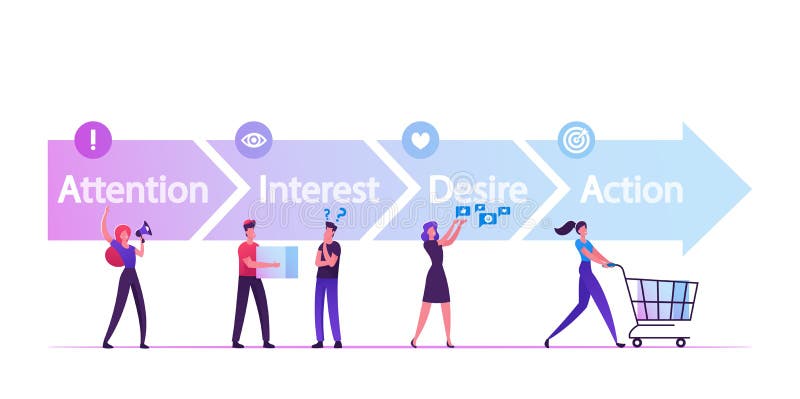
What have you understood by AIDA model and why do you think it’s still relevant up till today?
Let’s go through the journey so that you can understand each and every step.
Join Copywriter Salary Agency For More Powerful Marketing Contents.
The AIDA model was brought about by businessman Elias St. Elmo Lewis in the late 19th century. As an acronym, AIDA breaks down into the steps required for successful marketing: Attention, Interest, Desire (or sometimes, Decision) and Action. The AIDA marketing model is a bedrock of modern marketing, to the extent that missing one step is thought to almost guarantee an unsuccessful result.
Remember,
The mission of an advertisement is to attract a reader, so that he will look at the advertisement and start to read it; then to interest him, so that he will continue to read it; then to convince him, so that when he has read it he will believe it. If an advertisement contains these three qualities of success, it is a successful advertisement
Table of Contents
What is AIDA model?
The AIDA model is a marketing framework that stands for Attention, Interest, Desire, and Action. It represents the four stages a consumer typically goes through when encountering a product or service:
- Attention: This is the first step where the marketer aims to grab the audience’s attention by creating a compelling and attention-grabbing headline, image, or tagline. The goal is to make the consumer pause and take notice of the message.
- Interest: Once attention is captured, the marketer needs to maintain the consumer’s interest. This is achieved by providing relevant and engaging information about the product or service. The consumer should start developing an interest in how the product or service could meet their needs or solve their problems.
- Desire: In this stage, the marketer works to cultivate a desire or emotional connection in the consumer towards the product or service. This is typically achieved by highlighting the benefits, unique selling points, and advantages of the offering. The goal is to make the consumer feel that they want or need the product.
- Action: The final stage is where the consumer is encouraged to take action, such as making a purchase, signing up for a newsletter, or contacting the company. The call-to-action (CTA) should be clear, compelling, and easy to follow.
The AIDA model is considered a hierarchy of effects model, which means consumers must move through each stage of the model to complete the desired action.
“Grab their attention, ignite their interest, spark their desire, and watch them take action. That’s the power of AIDA in marketing.”
What are some examples of AIDA?
Attention:
- Catchy headlines or slogans that grab the reader’s attention.
- Eye-catching images or visuals that stand out.
- Bold colors or fonts that draw the viewer’s gaze.

Interest:
- Presenting a problem or challenge that the audience can relate to.
- Providing interesting statistics or facts that pique curiosity.
- Sharing a compelling story or anecdote that resonates with the audience.
Desire:
- Showcasing the benefits and features of a product or service.
- Using testimonials or reviews to build trust and credibility.
- Creating a sense of exclusivity or urgency to increase desire.
Action:
- Including a clear call to action (CTA) such as “Buy Now,” “Sign Up,” or “Learn More.”
- Providing easy-to-follow steps for the audience to take.
- Offering incentives like discounts, free trials, or limited-time offers to encourage immediate action.
Is there any differences between AIDA Model and AIDA formula?
The AIDA Model and AIDA Formula refer to the same concept in marketing and advertising, outlining the stages a customer goes through when engaging with a message or advertisement: Attention, Interest, Desire, and Action.
The terms “Model” and “Formula” are often used interchangeably to describe this sequential framework for understanding consumer behavior and crafting effective marketing campaigns. So, in essence, there’s no significant difference between the two terms; they both pertain to the same concept.
Applying the AIDA Model in the Real World:

Let’s consider an example of how the AIDA model can be applied in the context of a new smartphone launch:
Attention: The smartphone manufacturer creates teaser ads with bold visuals and intriguing taglines, sparking curiosity about the new device among consumers.
Interest: The company releases more detailed videos and articles showcasing the smartphone’s innovative features, high-performance camera, and long battery life. This piques the interest of potential buyers who are looking for advanced technology.
Desire: The manufacturer shares user testimonials and success stories, highlighting how the smartphone has transformed the lives of individuals by making their tasks easier and more enjoyable.
Action: To prompt action, the manufacturer offers limited-time pre-order discounts and bundles. Clear instructions guide consumers through the pre-order process, making it easy for them to secure the new smartphone.
Final thoughts on the AIDA Model
By understanding and implementing each stage, businesses can create content that engages customers and drives conversions. Remember that while the AIDA model provides a solid foundation, adapting it to modern digital landscapes is crucial for continued success.
We’ve compiled a great website for your online book shopping ????
You can get access HERE
